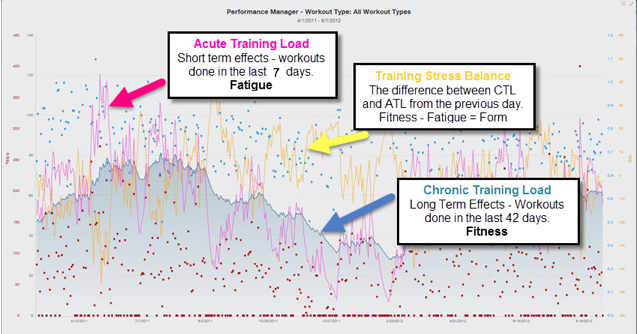TrainingPeaks Performance Management Chart (PMC)
The Performance Management Chart (PMC) helps track your training progression by monitoring three key metrics:
-
Chronic Training Load (CTL) – "Fitness"
- Measures long-term training load (6-week average Training Stress Score).
- Higher CTL = Greater endurance and workload capacity.
-
Acute Training Load (ATL) – "Fatigue"
- Represents short-term training load (7-day average TSS).
- High ATL indicates recent intense training, requiring adequate recovery.
-
Training Stress Balance (TSB) – "Form"
- TSB = CTL - ATL
- Positive TSB → Fresh and race-ready.
- Negative TSB → Fatigue accumulation, necessary for adaptation but requires balance.

What is TSS?
Training Stress Score (TSS) measures the workload of a workout based on intensity and duration:
- 100 TSS = 1 hour of cycling at threshold power/heart rate.
- 111 TSS = 1 hour of running at threshold pace/heart rate.
A short, intense session can have the same TSS as a long, easy workout, but it impacts the body differently.
Once a workout is completed, actual TSS updates your Performance Management Chart (PMC):
- Fitness (CTL) – 6-week average TSS (long-term training load).
- Fatigue (ATL) – 7-day average TSS (short-term load).
- Form (TSB) – Readiness to train (CTL minus ATL).
Does Higher CTL Mean Better Fitness?
Not always. CTL tracks accumulated training load but doesn’t guarantee peak performance.
- Too much low-intensity training → High CTL but limited speed/power.
- Too many hard sessions without recovery → Fatigue limits performance gains.
Recovery and CTL
Following a well-structured race-specific plan with the right intensity, volume, and recovery is better than solely targeting CTL metrics that may not optimize racing outcomes. Smart algorithms provide an overview of progress but overlook factors like tiredness, stress, nutrition, experience, and training history.
Phil's plan gradually ramps up training at a challenging yet manageable level, featuring two or three weeks of hard training followed by one active recovery week.
Focusing solely on increasing CTL can lead to consistently hard training without adequate recovery, which is less effective than the two or three hard weeks followed by a recovery week.
Tracking Progress Effectively
Performance is the best indicator of progress. Regular fitness tests in your plan help track improvements—just ensure they’re done under the same conditions for accurate comparisons.
As your fitness increases, your thresholds improve. Even if your Training Stress Score (TSS) remains the same, you're performing at a higher level.
Important To Note
The Performance Management Chart (PMC) can be misleading without accurate training thresholds in your settings.
Also, CTL is personal—comparing yours to someone else’s is pointless. A lower CTL doesn’t mean lower performance; a fitter athlete with higher thresholds can still outperform someone with a higher CTL.
4 Ways to Make the Most of Your Metrics
- Track threshold improvements – Regular fitness tests provide the most accurate measure of progress.
- Avoid CTL comparisons – Your CTL is unique to you; a higher number doesn’t always mean better performance.
- Update your thresholds – Adjust your TrainingPeaks settings after each fitness test to keep your data accurate.
- Think before accepting changes – TrainingPeaks may suggest automatic threshold updates, but review them carefully before applying.
Copyright MyProCoach™ Ltd © July 2020. All rights reserved.

Comments
0 comments
Please sign in to leave a comment.